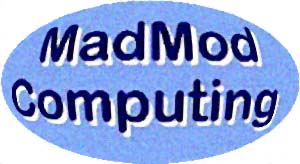
|
The MadMod Computing Newsletter March, 2009 - Vol. 2009a |

|
The MadMod Computing Newsletter March, 2009 - Vol. 2009a |
|
Welcome to this edition of The MadMod Computing Newsletter. We hope that you enjoy the features of each issue and learn some computing skills along the way. For more topics on other newsletters, check out MadMod Computing Newsletters. First, a reminder to make backups of your important files, and to keep your anti-virus software up-to-date. Second use a software firewall and/or a router if using broadband. Last, obtain all the critical Windows updates. |
|
Featured in This Issue |
|
1. Wireless SSID's 2. Powerline Network Extenders 3. Chess.com (website) |
|
1. Wireless SSID's SSID (Service Set Identifier) is the name of the broadcast signal from a wireless router that is picked up by computers using a wireless adapter. Default SSID's are usually the company name of the router's manufacturer, but it should be changed to something like 'HAL2009' so that the name doesn't "collide" with other routers in the vicinity using the same name. The name broadcast can be turned off for greater privacy, but those knowing the existing name can still connect using it. On the subject of wireless routers, the owner of it needs to consider whether the wireless signal should be an open system without encryption--the usual default for most home owners, or it should use WEP or WPA encryption--the most relevant choice for businesses.
Finally, it's a good idea to change the default password for the router itself from the factory default so that others cannot log into the router and thus change the settings.
|
|
2. Powerline Network Extenders Older buildings usually don't have Ethernet jacks for computers to use to connect to a router. Instead, connecting to a router is done using a wireless system. However, older buildings have problems relating to the thickness of walls, doors and floors which can cancel out wireless signals.
The way around the difficulty is to piggyback the network signals onto the electrical power lines in the building. Devices bridge the network signals to the power line wiring using a pair of small plugin adapters. One of the adapters connects by Ethernet cable to the router via a unit plugged into a wall power outlet. The other adapter plugged into a wall outlet somewhere else in the building simply reverses the signal conversion and connects to a computer. Powerline bridge extenders also may use wireless at the computer end of the chain. The cost for a pair of units is in the $100 - $150 range.
|
|
3. Chess.com (website) Chess.com Chess.com allows people to play a game of chess dynamically with another person over the Internet. Moves of the game are recorded and a chat pane is provided for simple dialog between the players. The board looks and functions normally as a chessboard with the pieces easily recognizable. Chess.com requires an account with a login name and password to make moves. Once logged in, it's easy to see if your opponent is also logged in at the same time by looking for a small flashing icon. If you make a move and your opponent is not logged in, an e-mail is sent automatically to remind them that it's now their move.
The website allows for multiple games and has help services for people wanting to improve their game. Chess.com can be used free, though the paid upgraded account has more features.
|